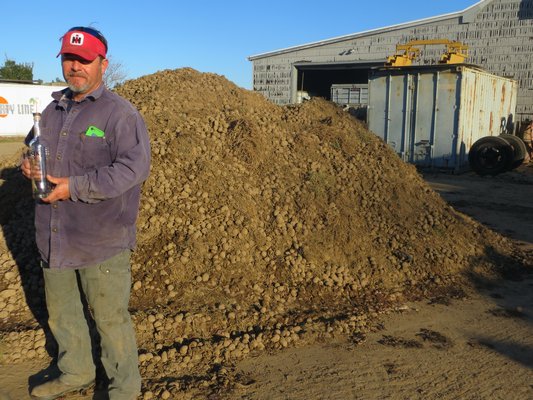
It is a clear day in late fall on the Foster farm, which means that the grumbling noise of potato graders is never far from earshot.But it seems that this will be the last wholesale potato season on the farm, as Dean Foster is moving his business in a new direction: craft spirits.
“It pains me that I can’t make money bringing a staple to market,” said Mr. Foster, whose family has been selling wholesale potatoes for six generations. He plans to launch Sagaponack Farm Distillery next summer. The catch? Nearly all the ingredients will be grown on the farm in Sagaponack.
“Farms like us, we have to do something because there is no money left in the table stock market,” said Mr. Foster, who believes that the past five to six years have been especially tough for small-scale farmers in New York State, like his family, who sell wholesale produce. “We’re being swallowed up by large corporate entities.”
Mr. Foster toyed with the idea of creating a distillery for the past eight years, and when Governor Andrew Cuomo signed legislation in 2012 to expand the existing 2007 Farm Distillery Act, allowing farm distilleries to sell their own liquor, Mr. Foster realized his opportunity.
“We have a really rich tradition and history of agriculture in New York State,” said Sam Filler, director of industry development at Empire State Development, a state agency that works to develop the economy. “The governor is very interested in finding value-add ways to continue growing.”
“I remember saying 15 years ago, ‘Dean, why don’t you do something fun with those potatoes?’” said Matt Beamer, brew master at Sagaponack Farm Distillery. Mr. Beamer is married to Mr. Foster’s cousin, Stephanie Brown-Beamer, and after 18 years as the brew master at Wasatch Brewery in Utah, he moved to Sagaponack two years ago to go into business with Mr. Foster.
Although Mr. Beamer’s alcohol experience is with beer, he is excited about the challenge that comes with distilling vodka, gin or absinthe. As for whiskey, the brewer is not concerned.
“Whiskey is basically distilled beer,” Mr. Beamer said with a laugh. Although a whiskey will take longer to bring to market, as it needs to ferment, Mr. Beamer is happy with the initial attempts he said, explaining, “I thought it would take more tries to be remotely drinkable.”
Sagaponack Farm Distillery plans to bring its first product, Sagaponacka Vodka, to market in spring 2016. Soon to follow will be brandies, gins and absinthes. Mr. Foster plans to self-distribute, something that he believes is possible thanks to the burgeoning slow food movement on the East End, which he said is due to the fertile soil on the South Fork.
“The food that is grown here is second to none,” he said. He plans to continue to grow at least 40 acres of potatoes for distribution to local restaurants. Mr. Foster would not specify which ones, but said he will cater to individual restaurants’ needs.
“The only way that the farmer is going to survive is niche-market,” said Mr. Foster, who believes that taxes, land regulation and big government are making it increasingly difficult for small-scale farmers. “There is no question that the real estate market out here is pinching farmers,” he said.
In 1987, his family was farming close to 800 acres of potatoes and corn on tracts of land from Amagansett to northern Bridgehampton. Now, the Fosters farm around 400 acres, only 180 acres of which they own. The other 220 acres are rented, something that Mr. Foster said is unsustainable in the long run. As land values on the East End continue to increase, there is less and less incentive to lease it to farmers, despite potential tax benefits thanks to the New York Agricultural Districts Law.
“I need to be able to make this business on my property,” Mr. Foster said. Luckily, his estate-style distillery can operate with 180 acres of land, something that would be very difficult for wholesale potato farming, as the profit margins are much smaller.
His sister, Marilee Foster, will continue to grow vegetables to sell at her farm stand. Mr. Foster said she will also grow herbs and spices for the spirits.
“The farms that are still here are the best of the best,” he said when speaking about the rapid development that farmers faced in the 1980s. “They decided that a farm is more important than a house.”